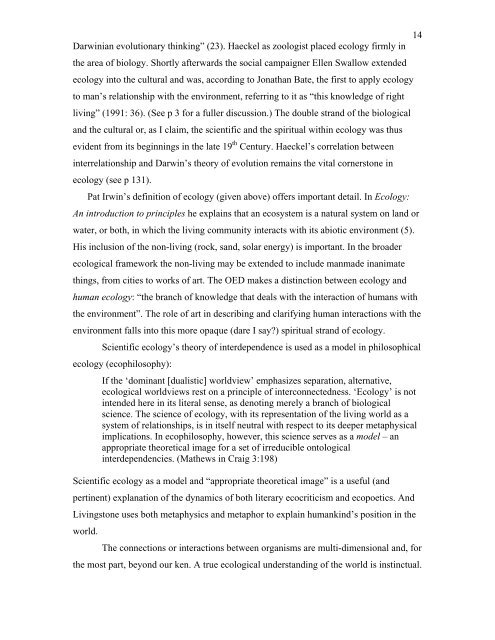"Symbiosis or Death": - Rhodes University
"Symbiosis or Death": - Rhodes University
"Symbiosis or Death": - Rhodes University
Create successful ePaper yourself
Turn your PDF publications into a flip-book with our unique Google optimized e-Paper software.
14<br />
Darwinian evolutionary thinking” (23). Haeckel as zoologist placed ecology firmly in<br />
the area of biology. Sh<strong>or</strong>tly afterwards the social campaigner Ellen Swallow extended<br />
ecology into the cultural and was, acc<strong>or</strong>ding to Jonathan Bate, the first to apply ecology<br />
to man’s relationship with the environment, referring to it as “this knowledge of right<br />
living” (1991: 36). (See p 3 f<strong>or</strong> a fuller discussion.) The double strand of the biological<br />
and the cultural <strong>or</strong>, as I claim, the scientific and the spiritual within ecology was thus<br />
evident from its beginnings in the late 19 th Century. Haeckel’s c<strong>or</strong>relation between<br />
interrelationship and Darwin’s the<strong>or</strong>y of evolution remains the vital c<strong>or</strong>nerstone in<br />
ecology (see p 131).<br />
Pat Irwin’s definition of ecology (given above) offers imp<strong>or</strong>tant detail. In Ecology:<br />
An introduction to principles he explains that an ecosystem is a natural system on land <strong>or</strong><br />
water, <strong>or</strong> both, in which the living community interacts with its abiotic environment (5).<br />
His inclusion of the non-living (rock, sand, solar energy) is imp<strong>or</strong>tant. In the broader<br />
ecological framew<strong>or</strong>k the non-living may be extended to include manmade inanimate<br />
things, from cities to w<strong>or</strong>ks of art. The OED makes a distinction between ecology and<br />
human ecology: “the branch of knowledge that deals with the interaction of humans with<br />
the environment”. The role of art in describing and clarifying human interactions with the<br />
environment falls into this m<strong>or</strong>e opaque (dare I say?) spiritual strand of ecology.<br />
Scientific ecology’s the<strong>or</strong>y of interdependence is used as a model in philosophical<br />
ecology (ecophilosophy):<br />
If the ‘dominant [dualistic] w<strong>or</strong>ldview’ emphasizes separation, alternative,<br />
ecological w<strong>or</strong>ldviews rest on a principle of interconnectedness. ‘Ecology’ is not<br />
intended here in its literal sense, as denoting merely a branch of biological<br />
science. The science of ecology, with its representation of the living w<strong>or</strong>ld as a<br />
system of relationships, is in itself neutral with respect to its deeper metaphysical<br />
implications. In ecophilosophy, however, this science serves as a model – an<br />
appropriate the<strong>or</strong>etical image f<strong>or</strong> a set of irreducible ontological<br />
interdependencies. (Mathews in Craig 3:198)<br />
Scientific ecology as a model and “appropriate the<strong>or</strong>etical image” is a useful (and<br />
pertinent) explanation of the dynamics of both literary ecocriticism and ecopoetics. And<br />
Livingstone uses both metaphysics and metaph<strong>or</strong> to explain humankind’s position in the<br />
w<strong>or</strong>ld.<br />
The connections <strong>or</strong> interactions between <strong>or</strong>ganisms are multi-dimensional and, f<strong>or</strong><br />
the most part, beyond our ken. A true ecological understanding of the w<strong>or</strong>ld is instinctual.

















